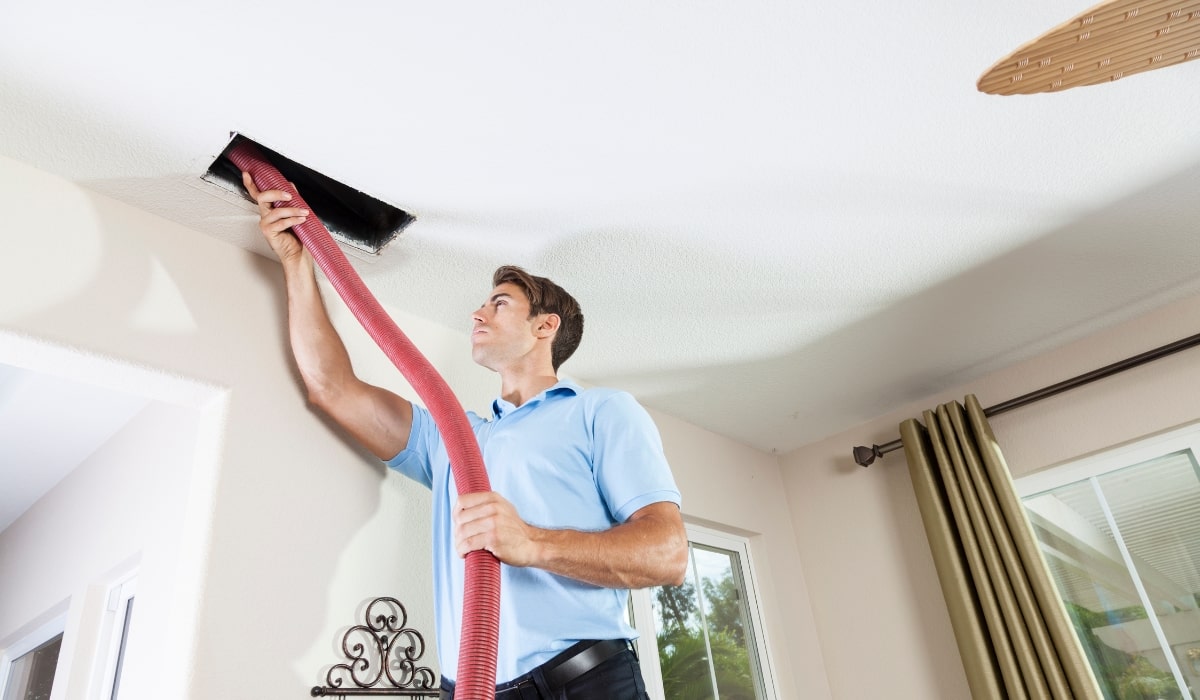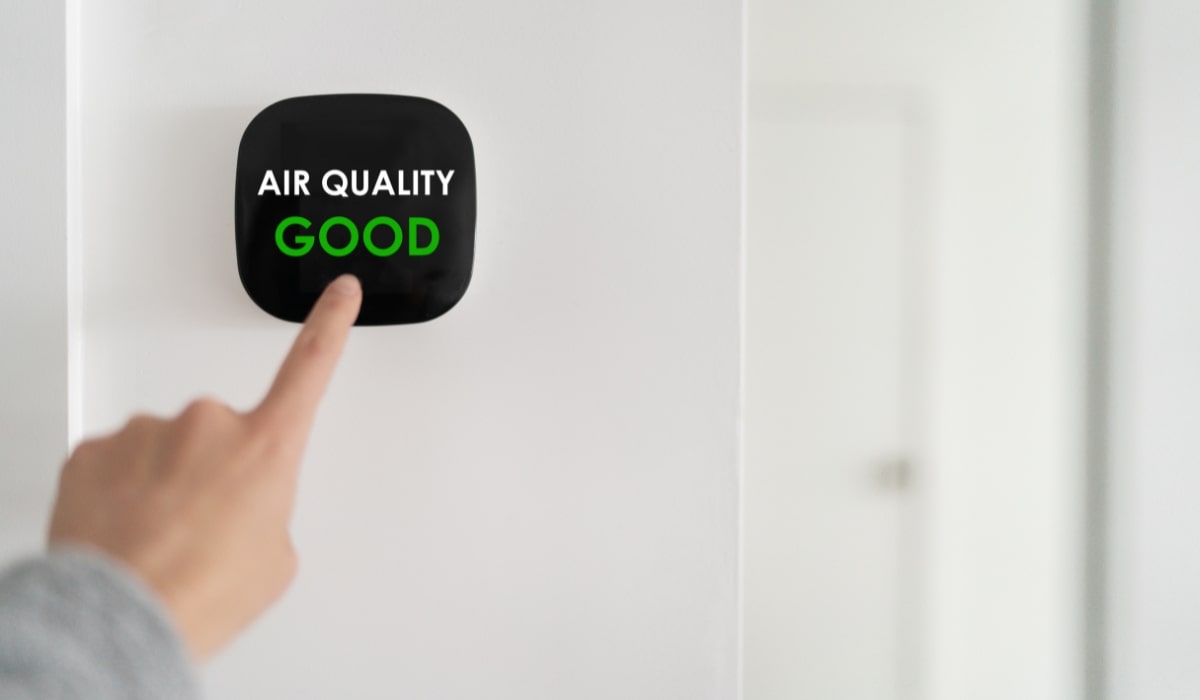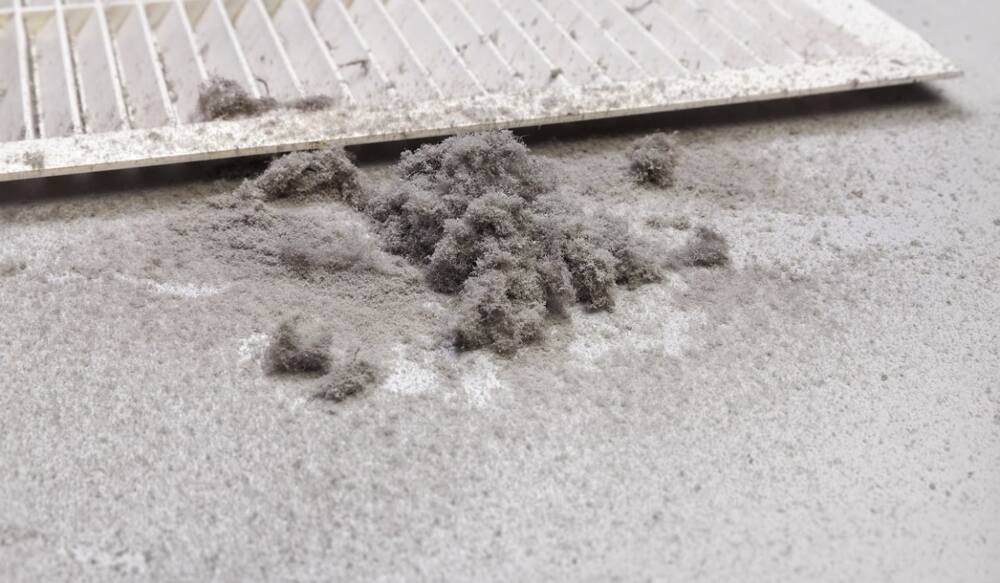When was the last time you thought about the cleanliness of your home’s ductwork? Chances are, it’s not something that crosses your mind very often. However, understanding duct cleaning and its importance can have a significant impact on the air quality in your home, as well as the overall efficiency of your HVAC system.
Today we will delve into the process of duct cleaning, explore the benefits it can provide, and discuss the essential maintenance practices to keep your ducts clean and functioning properly.
First and foremost, let’s take a closer look at why duct cleaning is necessary. Over time, your home’s ductwork can become a breeding ground for dust, debris, allergens, and even mold. These contaminants can circulate throughout your living space every time your HVAC system is running, leading to poor indoor air quality and potential health issues for you and your family.
To effectively clean your ducts, you’ll need the right tools and supplies. We will discuss the equipment required for a thorough duct cleaning and provide a step-by-step process to ensure you’re doing it correctly.
Why Should You Be Concerned With Duct Cleaning?
But why should you bother with duct cleaning in the first place? The benefits are plentiful. Not only does it improve the air quality in your home, but it also enhances the energy efficiency of your HVAC system. By removing the build-up of dust and debris, your system won’t have to work as hard to circulate air, resulting in lower energy bills.
Regular duct cleaning can also extend the lifespan of your HVAC system. When your ducts are clean, there is less strain on the system, reducing the likelihood of breakdowns and costly repairs.
Of course, maintaining clean ducts is just as important as cleaning them in the first place. We will provide you with some essential tips to keep your ducts in optimal condition, including regular inspections, the use of air purifiers, regular filter replacement, and proper HVAC system use.
While some homeowners may choose to tackle duct cleaning on their own, hiring a professional duct cleaner can offer several advantages. We will guide you through the process of selecting the right professional, including factors such as experience, certifications, services offered, customer reviews, and pricing.
Understanding the process, benefits, and maintenance of duct cleaning is crucial for every homeowner. By taking the necessary steps to keep your ducts clean and well-maintained, you can enjoy better air quality, improved energy efficiency, and a longer lifespan for your HVAC system. So, let’s dive in and discover everything you need to know about duct cleaning!
An Introduction to Duct Cleaning: Why It’s Important
When it comes to maintaining a healthy and comfortable home, the cleanliness of your ductwork plays a crucial role. Duct cleaning is the process of removing dust, debris, allergens, and other contaminants from the air ducts in your HVAC (Heating, Ventilation, and Air Conditioning) system. While duct cleaning may not be on the top of your to-do list, understanding its importance can have a significant impact on your indoor air quality and overall well-being.
The Impact of Indoor Air Quality
The quality of the air you breathe inside your home has a direct impact on your health. According to the Environmental Protection Agency (EPA), indoor air can be up to five times more polluted than outdoor air. The accumulation of dust, pet dander, pollen, mold spores, and other airborne particles in your ducts can contribute to poor indoor air quality.
When you turn on your HVAC system, these contaminants can be circulated throughout your home, potentially causing or exacerbating respiratory issues, allergies, and other health problems. This is especially critical for individuals with asthma or allergies.
Dust and Debris Build-up
Over time, dust and debris naturally accumulate in your air ducts. This can come from various sources, including pet hair, skin cells, pollen, and everyday household dust. As the debris builds up, it restricts the flow of air through your ducts, forcing your HVAC system to work harder to maintain the desired temperature.
The strain on your system can lead to reduced energy efficiency, higher utility bills, and increased wear and tear on your HVAC equipment. Additionally, clogged ducts can prevent proper air circulation, resulting in uneven cooling or heating throughout your home.
Allergens and Mold Growth
In addition to dust and debris, your ductwork can become a breeding ground for allergens and even mold. Moisture from condensation or humidity, combined with the presence of organic matter, creates an ideal environment for mold growth.
Mold spores can be released into the air when the HVAC system is running, potentially causing allergic reactions or respiratory issues. If left untreated, mold growth in your ducts can spread to other areas of your home and pose serious health risks.
Odor and Indoor Air Freshness
Have you noticed a musty or stale odor in your home? Dirty air ducts can contribute to unpleasant odors circulating throughout your living space. These odors can be caused by the accumulation of dust, pet dander, cooking smells, or even tobacco smoke in your ductwork.
By having your ducts cleaned regularly, you can eliminate these odors and improve the overall freshness of your indoor air.
Energy Efficiency and Cost Savings
Clean air ducts are essential for optimal energy efficiency. When your ducts are clogged with dust and debris, your HVAC system has to work harder to push air through the restricted pathways. This increased workload leads to higher energy consumption and subsequently higher utility bills.
By cleaning your ducts, you can improve the airflow and reduce the strain on your HVAC system, resulting in lower energy costs and increased energy efficiency.
Understanding the importance of duct cleaning is the first step towards ensuring a healthy living environment for you and your family. By removing contaminants, reducing allergens, and improving your HVAC system’s efficiency, duct cleaning can have numerous benefits. In the following sections, we will explore the process of duct cleaning in detail, the benefits it provides, and the essential maintenance practices to keep your ducts clean and functioning optimally.

Understanding the Duct Cleaning Process
Understanding the duct cleaning process is essential to ensure that the task is performed effectively and efficiently. In this section, we will delve into the various aspects of duct cleaning, including why it is necessary, the tools and supplies needed, and a step-by-step guide to the process.
Why Duct Cleaning is Necessary
Before diving into the process itself, it’s important to understand why duct cleaning is necessary. As mentioned earlier, over time, dust, debris, allergens, and even mold can accumulate in your air ducts. These contaminants can negatively impact the air quality in your home and potentially lead to health issues.
By cleaning your ducts, you can remove these accumulated particles, improve the airflow, and reduce the strain on your HVAC system. This not only enhances the air quality but also contributes to better energy efficiency and the longevity of your HVAC equipment.
Tools and Supplies Needed for Duct Cleaning
To effectively clean your ducts, you’ll need a few essential tools and supplies. Here are some of the common ones used in the duct cleaning process:
- Screwdrivers and wrenches: These are necessary for opening access panels and removing grilles or registers.
- Brushes: Different types of brushes, such as stiff bristle brushes and soft duct brushes, are used to dislodge and remove dust and debris from the ductwork.
- Vacuum cleaner: A high-powered vacuum cleaner with a long hose and brush attachment is used to suck up loose debris and prevent it from spreading throughout your home.
- Air compressor: An air compressor can be used to blow air through the ducts, dislodging stubborn debris and improving the effectiveness of the cleaning process.
- HEPA filter: A HEPA (High-Efficiency Particulate Air) filter is essential for trapping and containing the dust and particles during the cleaning process, preventing them from being released back into the air.
- Access tools: Depending on the layout and design of your ductwork, you may need specialized tools such as flexible rods or cameras to access hard-to-reach areas.
It’s important to note that while some homeowners may choose to perform duct cleaning themselves, it is often recommended to hire professional duct cleaners who have the necessary expertise and specialized equipment to ensure a thorough cleaning.
Step-by-Step Process of Duct Cleaning
Now let’s walk through a general step-by-step process of duct cleaning. Keep in mind that the specifics may vary depending on the layout and condition of your ductwork, as well as the tools and methods used by the professionals.
Step 1: Preparation
- Turn off your HVAC system to ensure safety and prevent the spread of dust and debris.
- Cover supply registers and return grilles with protective coverings to contain the dislodged particles.
Step 2: Inspection
- Inspect the ductwork visually to identify any signs of mold, excessive dust buildup, or other issues that may require additional attention.
- Check for any blockages or obstructions in the ducts.
Step 3: Cleaning the Supply Ducts
- Remove the grilles or registers from the supply ducts.
- Use brushes or compressed air to dislodge the dust and debris from the duct walls.
- Vacuum the loosened debris using a high-powered vacuum cleaner with a brush attachment.
- Repeat the process for each supply duct in your home.
Step 4: Cleaning the Return Ducts
- Follow the same process as cleaning the supply ducts, but this time focusing on the return ducts.
- Pay extra attention to cleaning the return grilles and filters.
Step 5: Cleaning the Main Trunk Line and Plenum
- The main trunk line and plenum are crucial components of your duct system.
- Use brushes, air compressors, or other appropriate tools to clean these larger sections thoroughly.
- Vacuum any dislodged debris to prevent it from spreading.
Step 6: Cleaning the Blower Motor and Fan
- Access the blower motor and fan assembly carefully.
- Clean the blades, housing, and other accessible parts using a soft brush and vacuum cleaner.
- Ensure that the blower motor and fan are free from dust and debris for optimal performance.
Step 7: Final Inspection and Reassembly
- Inspect the cleaned ducts and components for any remaining debris or signs of issues.
- Replace the grilles, registers, and filters that were removed during the cleaning process.
- Turn on your HVAC system and ensure that it is functioning properly.
It’s important to note that this is a general overview of the duct cleaning process. The specifics may vary based on your unique circumstances and the methods employed by professionals. Hiring experienced and certified duct cleaning professionals can ensure a thorough and effective cleaning, giving you peace of mind and improved indoor air quality.
In the next section, we will explore the benefits of regular duct cleaning and how it can positively impact your home and well-being.

The Benefits of Regular Duct Cleaning
Regular duct cleaning offers numerous benefits that contribute to a healthier and more comfortable living environment. In this section, we will explore the various advantages of keeping your ducts clean and well-maintained.
Improving Air Quality
One of the primary benefits of regular duct cleaning is the improvement in indoor air quality. Over time, dust, allergens, pet dander, and other contaminants can accumulate in your ductwork. When your HVAC system is running, these particles can be circulated throughout your home, leading to poor air quality and potential health issues.
By removing these contaminants through regular duct cleaning, you can significantly reduce the number of airborne particles in your living space. This is particularly important for individuals with respiratory conditions, allergies, or sensitivities to airborne pollutants.
Cleaner air means a healthier environment for you and your family, reducing the risk of respiratory symptoms and promoting overall well-being.
Enhancing Energy Efficiency
Another significant benefit of regular duct cleaning is improved energy efficiency. When your ducts are clogged with dust and debris, it restricts the airflow, causing your HVAC system to work harder to maintain the desired temperature.
This increased workload results in higher energy consumption and, consequently, higher utility bills. By cleaning your ducts, you remove the build-up of dust and debris, allowing for better airflow and reducing the strain on your HVAC system.
The improved airflow not only promotes energy efficiency but also helps your HVAC system to function optimally, leading to a longer lifespan and fewer repairs.
Extending the Lifespan of Your HVAC System
Proper maintenance, including regular duct cleaning, can significantly extend the lifespan of your HVAC system. When dust, debris, and other contaminants accumulate in your ducts, they can find their way into various components of your HVAC system, such as the blower motor, fan, and coils.
The presence of these particles can lead to increased wear and tear on these components, potentially resulting in breakdowns or the need for costly repairs. By keeping your ducts clean, you reduce the risk of damage to these critical parts of your HVAC system and ensure its longevity.
Regular duct cleaning, combined with routine HVAC maintenance, can help you avoid premature system failure and save you money in the long run.
Eliminating Unpleasant Odors
Dirty ducts can contribute to unpleasant odors circulating throughout your home. The accumulation of dust, pet dander, cooking smells, and other airborne particles can create a musty or stale odor.
By cleaning your ducts, you can eliminate these odors and improve the overall freshness of your indoor air. This is particularly beneficial for households dealing with persistent odors or individuals with sensitivities to certain smells.
Reducing Allergens and Irritants
For individuals suffering from allergies, asthma, or other respiratory conditions, regular duct cleaning can be especially beneficial. Dust, pollen, mold spores, and other allergens can accumulate in your ductwork, exacerbating these conditions and triggering allergic reactions or respiratory symptoms.
By removing these allergens through duct cleaning, you can create a healthier living environment with reduced allergen exposure. This can lead to fewer allergy-related symptoms, better respiratory health, and improved overall comfort for those affected.
In summary, regular duct cleaning offers a range of benefits, including improved air quality, enhanced energy efficiency, extended HVAC system lifespan, elimination of unpleasant odors, and reduced allergens and irritants. By investing in this essential maintenance task, you can create a healthier and more comfortable home for you and your family.
How to Maintain Clean Ducts
Once you have cleaned your ducts, it’s crucial to implement proper maintenance practices to keep them clean and functioning optimally. In this section, we will explore essential tips for maintaining clean ducts, including regular inspections, the use of air purifiers, filter replacement, and proper HVAC system use.
Regularly Inspect for Dust and Debris
Regular inspections are key to identifying any signs of dust, debris, or mold growth in your ducts. You can visually inspect the accessible parts of your ductwork, such as the grilles or registers, for any visible accumulation of dust or debris.
Additionally, pay attention to any musty odors or signs of mold, as these can indicate a potential issue within your ducts. If you notice excessive dust or mold growth, consider scheduling a professional duct cleaning to address the problem promptly.
Use of Air Purifiers
Air purifiers can be a valuable addition to your home’s HVAC system to help maintain clean ducts and improve indoor air quality. These devices work by filtering out airborne particles, including dust, allergens, and bacteria.
Consider investing in high-quality air purifiers with HEPA filters, as they are highly effective in capturing even the smallest particles. Place the air purifiers strategically throughout your home to ensure optimal air purification.
While air purifiers can help reduce the amount of dust and contaminants in the air, they should not replace regular duct cleaning. The combination of both will provide the best results in maintaining clean and healthy indoor air.
Regular Filter Replacement
Regularly replacing your HVAC system’s filters is crucial for maintaining clean ducts. Filters are designed to capture dust, pollen, and other airborne particles, preventing them from entering and accumulating in your ductwork.
Over time, filters become clogged with the captured particles, reducing their effectiveness and hindering airflow. This can lead to poor air quality and strain on your HVAC system.
Refer to your HVAC system’s manufacturer guidelines for the recommended filter replacement schedule. Generally, it is recommended to replace filters every three to six months, although it may vary depending on factors such as the type of filter, the level of pollutants in your area, and the presence of pets.
Regular filter replacement ensures that your HVAC system operates efficiently, reduces the accumulation of dust in your ducts, and contributes to cleaner indoor air.
Proper HVAC System Use
Properly using your HVAC system can also help in maintaining clean ducts. Here are some practices to keep in mind:
- Set your thermostat to the appropriate temperature to avoid excessive cycling of your HVAC system, which can stir up dust and debris within the ducts.
- Keep doors and windows closed when your HVAC system is running to prevent the entry of outdoor pollutants.
- Ensure proper insulation and sealing of your home’s windows, doors, and ductwork to minimize the infiltration of dust and contaminants.
- Regularly clean and maintain your HVAC system, including the blower motor, coils, and other components, as recommended by the manufacturer or a professional technician.
- Keep your home clean by regularly dusting, vacuuming, and minimizing clutter, as this reduces the amount of dust that can enter the ducts.
By following these practices, you can help maintain clean ducts and promote a healthier and more efficient HVAC system.
In the next section, we will discuss what to look for when hiring professional duct cleaners and factors to consider to ensure you choose the right service provider.

Hiring Professional Duct Cleaners: What to Look For
When it comes to duct cleaning, hiring a professional service provider is often the best option. Professional duct cleaners have the expertise, specialized equipment, and knowledge to effectively clean your ducts and ensure optimal results. In this section, we will discuss what to look for when hiring professional duct cleaners and the factors to consider to ensure you choose the right service provider.
Experience and Certifications
When selecting a professional duct cleaning company, experience is a crucial factor to consider. Look for companies with a proven track record in the industry and years of experience in duct cleaning. An experienced company is more likely to have encountered a variety of ductwork configurations and cleaning challenges, allowing them to handle your specific needs effectively.
Additionally, certifications and accreditations demonstrate the expertise and commitment of the duct cleaning company. Look for certifications such as the National Air Duct Cleaners Association (NADCA) certification, which ensures that the company follows industry standards and best practices.
Services Offered
Consider the range of services offered by the duct cleaning company. Do they provide a comprehensive cleaning process that covers all aspects of your HVAC system, including the main trunk line, supply ducts, return ducts, and other components? Ensure that the company offers a thorough and detailed cleaning process to achieve optimal results.
Additionally, inquire about any additional services they may provide, such as coil cleaning, blower motor cleaning, or dryer vent cleaning. These additional services can contribute to better indoor air quality and overall system performance.
Customer Reviews and Ratings
Take the time to research and read customer reviews and ratings of the duct cleaning company. Online platforms and review websites can provide valuable insights into the experiences of previous customers. Look for positive reviews that highlight the company’s professionalism, reliability, and the effectiveness of their duct cleaning services.
If possible, ask for references from the company and reach out to past customers to inquire about their satisfaction with the services provided. This can give you a firsthand account of the company’s reputation and the quality of their work.
Price and Value
While price should not be the only determining factor, it is important to consider the cost of the duct cleaning service. Obtain quotes from multiple companies and compare them based on the services offered, the level of expertise, and the reputation of the company.
Keep in mind that the cheapest option may not always provide the best value. Consider the overall value you will receive in terms of the quality of the cleaning, the professionalism of the company, and the long-term benefits to your indoor air quality and HVAC system performance.
Insurance and Guarantees
Ensure that the duct cleaning company is adequately insured. This protects you in case of any accidents or damage that may occur during the cleaning process. A reputable company will have liability insurance and workers’ compensation coverage for their employees.
Additionally, inquire about any guarantees or warranties offered by the company. A guarantee provides you with assurance that the company stands behind their work and will address any issues or concerns that may arise after the cleaning process.
By considering these factors when hiring professional duct cleaners, you can ensure that you choose a reputable, experienced, and reliable service provider. This will give you peace of mind knowing that your ducts are being cleaned by professionals who will deliver optimal results.
With this comprehensive guide to understanding duct cleaning, the process, benefits, maintenance, and hiring professionals, you are now equipped with the knowledge to make informed decisions about the cleanliness and maintenance of your home’s ductwork. By taking proactive steps to clean and maintain your ducts, you can improve indoor air quality, enhance energy efficiency, and enjoy a healthier and more comfortable living environment.
Contact Valley Comfort Heating and Air today!




